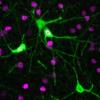A rare missense variant in RCL1 segregates with depression in extended families.
Depression is the most prevalent psychiatric disorder with a complex and elusive etiology that is moderately heritable. Identification of genes would greatly facilitate the elucidation of the biological mechanisms underlying depression, however, its complex etiology has proved to be a major bottleneck in the identification of its genetic risk factors, especially in genome-wide association-like studies. In this study, we exploit the properties of a genetic isolate and its family-based structure to explore whether relatively rare exonic variants influence the burden of depressive symptoms in families. Using a multistep approach involving linkage and haplotype analyses followed by exome sequencing in the Erasmus Rucphen Family (ERF) study, we identified a rare (minor allele frequency (MAF)=1%) missense c.1114C>T mutation (rs115482041) in the RCL1 gene segregating with depression across multiple generations. Rs115482041 showed significant association with depressive symptoms (N=2393, β=2.33, P-value=1 × 10) and explained 2.9% of the estimated genetic variance of depressive symptoms (22%) in ERF. Despite being twice as rare (MAF<0.5%), c.1114C>T showed similar effect and significant association with depressive symptoms in samples from the independent population-based Rotterdam study (N=1604, β=3.60, P-value=3 × 10). A comparison of RCL1 expression in human and mouse brain revealed a striking co-localization of RCL1 with the layer 1 interlaminar subclass of astrocytes found exclusively in higher-order primates. Our findings identify RCL1 as a novel candidate gene for depression and offer insights into mechanisms through which RCL1 may be relevant for depression.
2024. Transl Psychiatry, 14(1):103.
2022. PLoS Comput Biol, 18(5)e1009816.
